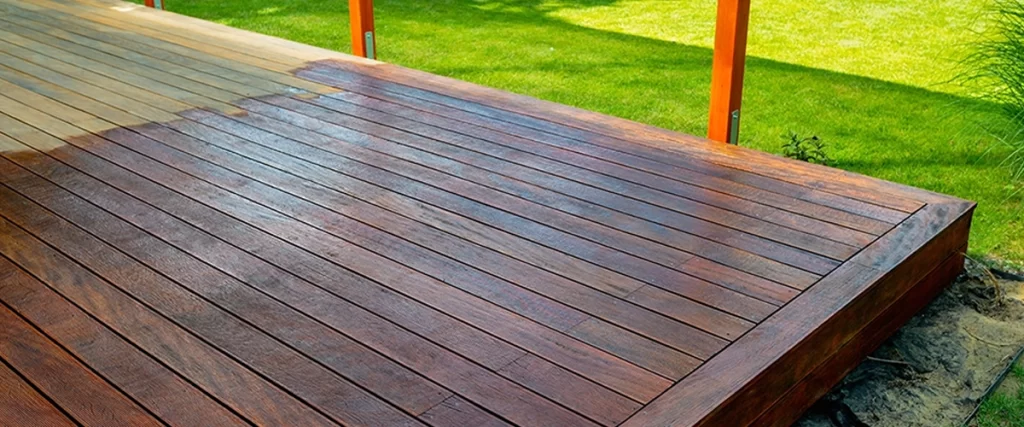If you’re planning a new deck or replacing an aging one, the composite vs wood decking decision shapes how your outdoor space looks, feels, and holds up over time. Both options can create a beautiful, durable deck.
The better choice depends on the climate you live in, the level of maintenance you’re comfortable with, and your budget now versus your long-term costs.
A Quick Side-By-Side
| Category | Composite Decking | Wood Decking |
| Upfront Cost | Higher | Lower (pressure treated pine is the budget leader) |
| Maintenance | Low, no regular staining | High maintenance, regular staining or painting |
| Durability | Excellent moisture and insect resistance | Can be durable with care, susceptible to rot if neglected |
| Appearance | Wide design options, consistent color | Natural wood grain, customizable with stain |
| Lifespan | Long, fewer frequent replacements | Shorter lifespan without rigorous care |
| Environmental Notes | Uses recycled materials, long service life | Renewable material, requires finishes and more upkeep |

What Counts As “Composite” And “Wood”
Composite decking blends wood fibers with recycled plastic and other composite materials. Composite manufacturers extrude that mix into composite decking boards in a wide range of colors and textures. Some lines include PVC decking, which is all plastic and even more moisture resistant. Composite decking offers consistent color, matching trim, hidden fastener systems, and low maintenance.
Wood decking includes pressure treated wood, cedar, and redwood, as well as less common hardwoods. Pressure treated pine is the most budget-friendly, widely available through local lumber yards, and strong enough for most structures.
Real wood delivers natural beauty, a warm underfoot feel, and the ability to stain or paint, but it needs regular maintenance to keep rot, mold, and water damage at bay.
Cost: Initial Vs Long-Term
Initial costs
Wood decking, especially pressure-treated, usually wins on day-one price. If you need to hit a tight budget for a large outdoor deck, wood’s lower material cost is hard to beat.
Maintenance costs
Composite decking requires less maintenance over its life. No regular staining or painting, no sealing, and fewer repairs. Wood needs annual maintenance in many climates: cleaning, inspections, and periodic stain or paint. Those routine tasks add up to real money over the years.
Long term value
With wood, the shorter lifespan of coatings and the likelihood of board replacements can narrow the initial savings. Composite’s long term costs often end up lower, especially for many homeowners who prefer less maintenance and fewer surprises.
Durability And Everyday Performance
Moisture and mold
Composite and PVC resist moisture better than traditional wood, reducing mold risk and swelling. Pressure treated wood holds up well structurally but can still cup or check if it dries too quickly or stays wet too long.
Insect damage and rot
Composite is not a food source for insects. Pressure treated wood resists insects and rot, yet cut ends and fastener penetrations still need sealing to protect against water intrusion.
Sun and color
Modern deck building materials include UV inhibitors that reduce fading. Real wood weathers to a silvery patina unless you maintain color with stain. If you love that natural wood silver-gray, real wood ages beautifully.
Structural integrity
Framing should be built from pressure treated lumber regardless of deck surface. Composite boards span joists differently than wood boards, so joist spacing must follow the manufacturer’s page of instructions for structural integrity and warranty.
Maintenance: What’s Really Required
Composite and PVC
- Seasonal wash with a deck cleaner and soft brush
- No sanding, sealing, staining, or painting
- Spot-clean spills to prevent staining on lighter colors
Wood (Pressure Treated, Cedar, Redwood)
- Annual cleaning and inspections
- Regular staining or painting every few years, more often on south and west exposures
- Sealing cut ends, replacing damaged boards, tightening fasteners as wood moves
If you want minimal maintenance, composite is the easy winner. If you enjoy hands-on care and the character that comes with it, natural wood remains a compelling choice.
Environmental Impact
Eco-conscious consumers often look at recycled materials and frequent replacements:
- Composite incorporates recycled plastic and reclaimed wood fibers, keeping plastic out of landfills and reducing demand for virgin materials. Its longer service life can mean fewer replacements. End-of-life recycling varies by brand and local facilities.
- Wood is renewable and stores carbon during its life, but it can require high maintenance and finishing products. Sourcing matters: look for responsibly harvested lumber and low-VOC stains to reduce environmental impact.
There’s no one “most environmentally friendly” answer. Consider longevity, maintenance required, and the materials involved in your finish plan.
Design Options And Aesthetics
- Composite offers color-fast boards, realistic wood-grain embossing, picture-frame borders, and trim kits. It’s easy to keep a consistent look year to year, which helps if you add onto the deck later.
- Wood brings natural beauty you can’t fully replicate, especially with knotty character, tight grain, or a hand-rubbed stain. You can shift color over time with new stains, and custom details are straightforward for a seasoned carpenter.
Where Each Shines
Choose composite when:
- You want low maintenance and less time on annual maintenance
- Your deck sits near sprinklers, pools, or heavy shade with moisture
- You prefer consistent color, hidden fasteners, and clean modern lines
- You’re planning a dream deck and want long term value with fewer headaches
Choose wood when:
- You value real wood character and a softer, natural underfoot feel
- You like the option to restain as your style changes
- You’re working within tight initial costs and are comfortable with regular maintenance
- You want to DIY board-level fixes without color-matching concerns

Common Questions
Is composite slippery when wet?
Quality boards are engineered with textured surfaces to manage traction. Always check specific slip ratings if the deck is near water.
Can I mix materials?
Yes. Many homeowners use composite for deck boards and low-maintenance railings, then add real wood accents on stairs or privacy screens for warmth.
What about heat?
All dark boards, wood or composite, can get hot in full sun. Lighter colors, shade structures, and airflow under the deck help manage surface temperature.
Will composite save money on structure?
The frame remains pressure treated lumber. Composite doesn’t change joist and beam costs, but it reduces the maintenance on the walking surface.
How do PVC boards compare?
PVC decking is all plastic, even more moisture resistant, and often a bit lighter. It typically costs more than composite but excels in wet or coastal environments.
Your Deck, Your Way
We’ll walk your space, bring real samples, and lay out clear side-by-side pricing and maintenance so you can choose with confidence. Want a fast, accurate plan for your deck building? Reach us at (765) 620-4668 or contact us for more information.
